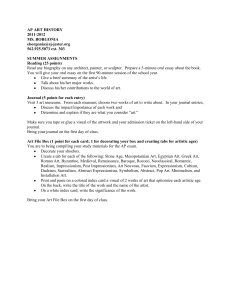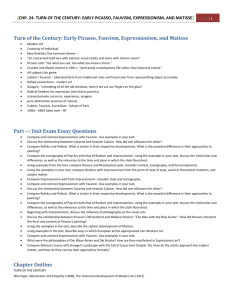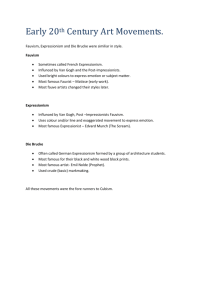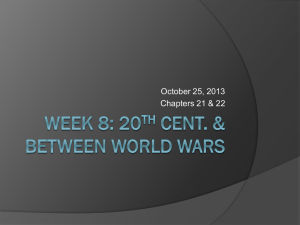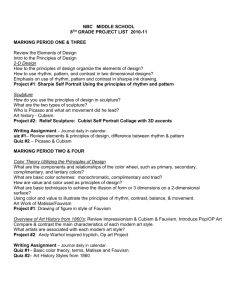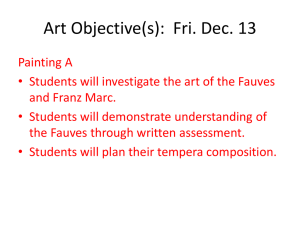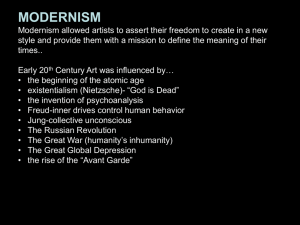Turn of the Century: Early Picasso, Fauvism, Expressionism, and
advertisement
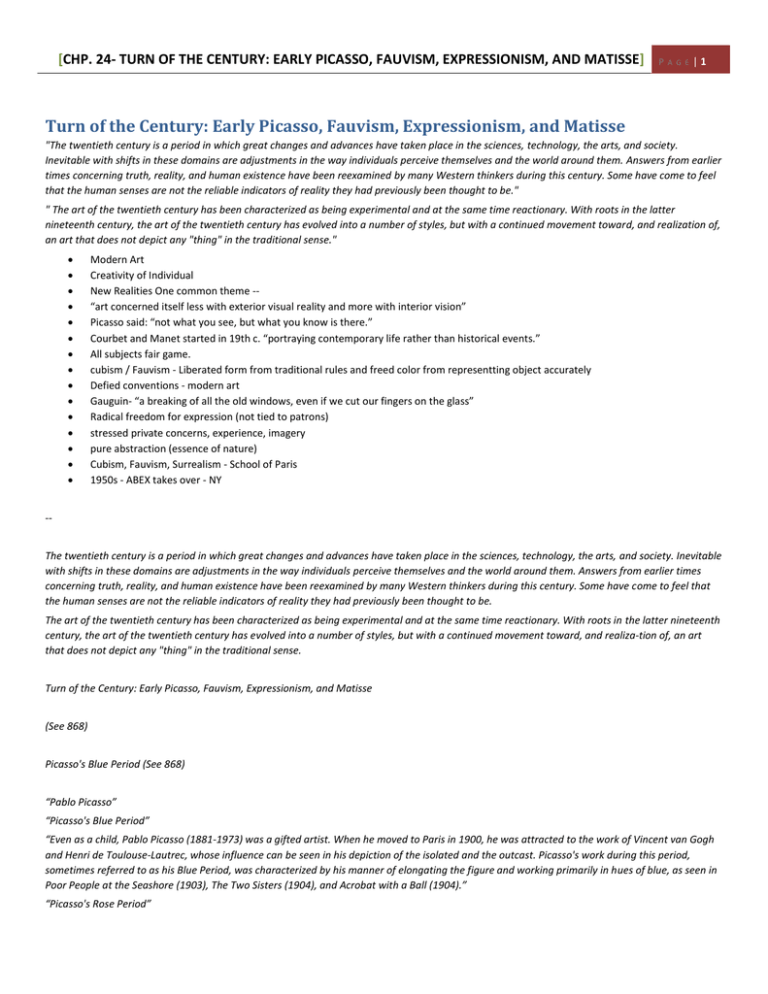
[CHP. 24- TURN OF THE CENTURY: EARLY PICASSO, FAUVISM, EXPRESSIONISM, AND MATISSE] P A G E |1 Turn of the Century: Early Picasso, Fauvism, Expressionism, and Matisse "The twentieth century is a period in which great changes and advances have taken place in the sciences, technology, the arts, and society. Inevitable with shifts in these domains are adjustments in the way individuals perceive themselves and the world around them. Answers from earlier times concerning truth, reality, and human existence have been reexamined by many Western thinkers during this century. Some have come to feel that the human senses are not the reliable indicators of reality they had previously been thought to be." " The art of the twentieth century has been characterized as being experimental and at the same time reactionary. With roots in the latter nineteenth century, the art of the twentieth century has evolved into a number of styles, but with a continued movement toward, and realization of, an art that does not depict any "thing" in the traditional sense." Modern Art Creativity of Individual New Realities One common theme -“art concerned itself less with exterior visual reality and more with interior vision” Picasso said: “not what you see, but what you know is there.” Courbet and Manet started in 19th c. “portraying contemporary life rather than historical events.” All subjects fair game. cubism / Fauvism - Liberated form from traditional rules and freed color from representting object accurately Defied conventions - modern art Gauguin- “a breaking of all the old windows, even if we cut our fingers on the glass” Radical freedom for expression (not tied to patrons) stressed private concerns, experience, imagery pure abstraction (essence of nature) Cubism, Fauvism, Surrealism - School of Paris 1950s - ABEX takes over - NY -The twentieth century is a period in which great changes and advances have taken place in the sciences, technology, the arts, and society. Inevitable with shifts in these domains are adjustments in the way individuals perceive themselves and the world around them. Answers from earlier times concerning truth, reality, and human existence have been reexamined by many Western thinkers during this century. Some have come to feel that the human senses are not the reliable indicators of reality they had previously been thought to be. The art of the twentieth century has been characterized as being experimental and at the same time reactionary. With roots in the latter nineteenth century, the art of the twentieth century has evolved into a number of styles, but with a continued movement toward, and realiza-tion of, an art that does not depict any "thing" in the traditional sense. Turn of the Century: Early Picasso, Fauvism, Expressionism, and Matisse (See 868) Picasso's Blue Period (See 868) “Pablo Picasso” “Picasso's Blue Period” “Even as a child, Pablo Picasso (1881-1973) was a gifted artist. When he moved to Paris in 1900, he was attracted to the work of Vincent van Gogh and Henri de Toulouse-Lautrec, whose influence can be seen in his depiction of the isolated and the outcast. Picasso's work during this period, sometimes referred to as his Blue Period, was characterized by his manner of elongating the figure and working primarily in hues of blue, as seen in Poor People at the Seashore (1903), The Two Sisters (1904), and Acrobat with a Ball (1904).” “Picasso's Rose Period” [CHP. 24- TURN OF THE CENTURY: EARLY PICASSO, FAUVISM, EXPRESSIONISM, AND MATISSE] P A G E |2 “Picasso's Rose Period (1905-1906) represents the stage in his artistic development when he tempered the severity of forms and color seen during his Blue Period. Typical subjects during his Rose Period are circus scenes, harlequins, and the nude. Examples of this genre of painting include The Family of Harlequins (1905), Acrobat with a Dog (1905), and The Juggler (1905).” Wallace Stevens: "The Man with the Blue Guitar" (See 869) Window on the World Eleven African Art and the European Avant-Garde (See 870) Henri Matisse and Fauvism(See 874) “Fauvism” ““ “Fauvism was not so much a school of art reflecting a particular theory as it was a fairly brief movement that celebrated the intensity of pure color. At the 1905 Salon d'Automne, Henri Matisse and twelve other colorists exhibited their work, which was so startling that it created a scandal. The following year, they again exhibited their work together at the Salon des Independants, where the art critic Louis Vauxcelles referred to their work as Les Fauves, the "wild beasts," a term that caught on.” “Henri Matisse” “The central figure of Fauvism was Henri Matisse (1869-1954), who studied under Gustave Moreau (1826--1989) at the Ecole Nationale des BeauxArts. Under Moreau's guidance, Matisse studied the masters as well as nature. His early work was fairly traditional until he was exposed to the Impressionists in the 1890s and he began to experiment with brighter color.” “Nothing in Matisse's work was accidental. Though he was con­sidered uninhibited by some critics, his paintings were the result of painstaking planning. His use of flat fields of color and his manner of simplifying the form of the human figure are seen in his painting Le Luxe (1907-1908). Through the use of overlapping forms and shapes, he was still able to maintain a sense of space and depth in his composi-tion. Though his treatment of the human figure may seem contrived and unsophisticated, to the contrary, it reflects his intimate knowledge of the human figure such that he was able to reduce it to a form that served his visual purpose. His approach reflected the degree to which he emphasized and valued his expression of a subject or theme above the actual depiction of that subject or theme.” “The Red Room (1908-1909) further illustrates Matisse's use of the color of the Post-Impressionists. In this work, he contrasts warm colors with cool colors and curving lines with straight lines, creating a decora-tive composition that, while conveying a sense of ambiguous space, maintains the viewer's attention toward the surface of the canvas.” “Georges Rouault” “A colleague of Matisse's at the Ecole Nationale des Beaux-Arts was Georges Rouault (1871-1958). Rouault's early training had been as an apprentice to a stained-glass painter, and his teacher at the Ecole Nationale des Beaux-Arts, Gustave Moreau, recognized early on that Rouault would likely have a difficult time resolving his attraction to powerful images with his desire to achieve linear detail. The themes and subjects that Rouault chose to depict centered upon the religious and the social, and his treatment of peasants, prostitutes, clowns, and other individuals raised his subjects to allegorical proportions. His manner of depiction is seen in his painting The Old King (1916-1937). This work reflects his familiarity with the art of stained glass in the way the powerful black lines of the figure recall the leaded divisions of stained-glass windows.” Expressionism (See 876) “Expressionism” “Unlike some of the art movements that have been discussed, such as Impressionism and Fauvism, Expressionism was not so much a particular art movement as it was a trend or tendency that has surfaced from time to time. The individuals who represented the initial Expres-sionist movement, which developed as a response to Impressionism and the formal approach of painters such as Paul Cezanne and Georges Seurat, included Vincent van Gogh and Edvard Munch. Their subjective approach to their art was manifested in both their use of vivid color and their depiction of dramatic themes.” [CHP. 24- TURN OF THE CENTURY: EARLY PICASSO, FAUVISM, EXPRESSIONISM, AND MATISSE] P A G E |3 “Emil Nolde; Ernst Kirchner” “For the German painters, especially the members of the groups Die Brucke (The Bridge) and Der Blaue Reiter (The Blue Horseman), who would become the German Expressionists, it was Fauvism that was the prime influence, prompting them to develop an art that reflected their personal sensations toward both life and their imaginations. Among these German painters were Emil Nolde (1867-1956) and Ernst Kirchner (1880-1938). Kirchner, one of the founders of the Brucke style in 1905, was influenced by Edvard Munch. In his paintings, Kirchner strove to simplify form and color, and he was attracted to the sensuous nature of the female nude and to the intensity of athletics. Though Nolde briefly belonged to the Brucke group between 1906 and 1907, he preferred to work alone. Paintings such as his Warrior and His Wife (1912) and Marsh Landscape (1916) illustrate his use of brilliant color and his belief that color did not represent reality, it was reality.” The Bridge (Die Brucke)(See 876) The Blue Rider (Der Blaue Reiter)(See 878) Art History and Aesthetics in Early Twentieth- Century Munich (See 878) Käthe Kollwitz(See 880) “George Grosz; Kathe Kollwitz” “The role of art as a commentator upon social conditions and situations also found fertile ground in Germany during the early decades of the twentieth century. Although George Grosz (1893-1959) trained as a painter and is known for such works as Punishment (1934), he is probably best known for his satirical drawings, such as The Entree (1929), which challenged the absurdities of World War I, the postwar years, and, in general, the materialistic tendencies of the middle class. Kathe Kollwitz (1867-1945) found the woodcut to be a very effective medium to convey somber subjects and themes, as seen in her Memorial” “to Karl Liebknecht (1919).” “Oskar Kokoschka” “The use of powerful brush strokes and intense color as a means of conveying impassioned, powerful sentiment can also be seen in the work of the Viennese painter Oskar Kokoschka (1886-1980), who was greatly influenced by Klimt. During his lifetime, much of Kokoschka's work was rejected by a public that found his paintings to be offensive. Living in Vienna at the same time that Sigmund Freud was investigating the possibilities of psychoanalysis, Kokoschka was creating paintings that might be characterized as visionary, depicting the physical trans-formation of his subjects and exploring the subconscious, as seen in his Bride of the Wind (1914). Here, the vigorous strokes of Kokoschka's brushwork are used to depict both landscape and lovers as tattered forms. As in many Expressionist works, there is a sense of violence to the handling of the pigment in a very textural way and in the manner in which colors are placed adjacent to one another.” “Max Beckmann” “Max Beckmann (1884-1950) is considered by some historians to be a German Impressionist and by others to be a German Expressionist. His paintings focused upon the power of the human figure, in degrada-tion as well as in honor. A first-hand experience of war between 1914 and 1918 and the political persecution that caused him to flee Frankfurt in 1933 led Beckmann to create haunting images of disfigured in-dividuals, cripples, and bizarre figures, conveying his feelings toward “the sufferings of humanity. During the latter part of his career, he painted seven large, symbolically complex triptychs. Probably the most famous of these is Departure (1932-1933). The two outer panels of the triptych portray dark, somber scenes of bondage and torture. The middle panel, in contrast, is a daylight scene, what appears to be a royal family in a boat [see illustration 15]. His simplified figures, delineated with heavy black lines, contribute toward an overall effect that is intense and powerful.” “Wassily Kandinsky” “In the work of Wassily Kandinsky (1866-1944), the concept of color serving as the content of paintings came to fruition. Whereas earlier painters had retained some elements of the objective world in their work, Kandinsky focused his attention exclusively upon the affec-tive and psychological aspects of color and form, such that his paintings were nonfigurative in depiction. His first nonfigurative work, Abstract Water Color (1910), is evidence of his ability to separate the realm of art from the realm of nature and thus to create paintings that were devoid of representation.” “It was from the Blaue Reiter Year Book, which Kandinsky and the German painter Franz Marc (1880-1916) produced, that the Blaue Reiter group of German Expressionists took its name. By the second decade of the twentieth century, Kandinsky had developed two types of paintings. His compositions, such as Unbiegsam (1929), consisted of purposefully ordered geometric forms, while his improvisations, such as Improvisation 28 (1912) and Improvisation 30 (1913), were more spontaneous.” [CHP. 24- TURN OF THE CENTURY: EARLY PICASSO, FAUVISM, EXPRESSIONISM, AND MATISSE] P A G E |4 Matisse after Fauvism Harmony in Red Dance I 882 Piano Lesson 882 Jeannette V 884 Later Works 884 Fauvism (1904-1908) French the avant-garde was originally a military term, referring to the detachment of soldiers that went first into battle. By the 1880's, younger artists began to refer to themselves as the avant-garde. The fauves (wild beasts) gained this name through the use of wild, subjective colors. Henry Matisse used color to convey emotions, freed from its role in describing objects. In The Joy of Life, we see colors used arbitrarily to describe the artist’s feeling, not the landscape itself. Fauvism did not last long, a mere three years or so, but was crucial for the development of modern art. Fauvism was part of a larger trend in Europe called Expressionism, which arose as artists came to believe that the fundamental purpose of art was to express their intense feelings toward the world. Surface pattern Bright, non-realistic colors Equal emphasis on all objects No shadow, no perspective Overall flat, ornamental effect means "wild beasts" in French, referring to use of wild color and flat planes associated with the work of Cezanne Henri Matisse used flat planes and bright vivid color. He was most interested in planes. "Artists experimented with media and invented new forms while retaining their uniqueness and individuality. They found in primitive art a spontaneity, energy, and design that affected their expressions." Moved from Value to COLOR First 20th c movement Polynesian decorative wood carving textiles of So American sculpture “Fauvism was not so much a school of art reflecting a particular theory as it was a fairly brief movement that celebrated the intensity of pure color. " "At the 1905 Salon d'Automne, Henri Matisse and twelve other colorists exhibited their work, which was so startling that it created a scandal." " Their exhibition in Paris (1905) showed paintings that freed color from descriptive representation and, with bold brush strokes and heavy pigment, made the picture surface a single spatial plane." "The following year, they again exhibited their work together at the Salon des Independants, where the art critic Louis Vauxcelles referred to their work as Les Fauves, the "wild beasts"” "nicknamed the Fauves ("wild beasts") because of their unrestrained use of color and boldly expressionistic drawing styles." Henri Matisse "is known primarily for his elegant portraits, complex still lifes, and interior scenes often embellished with intricate arabesquelike patterns and large, flat planes of brilliant color. "An advocate of a frankly decorative style, Matisse once said that a painting should feel like a "comfortable armchair" after a long and tiring day. " "In addition to painting he experimented with sculpture (figural abstractions) and, bedridden in his later years, with cut-paper compositions of brilliant, high-intensity color" [CHP. 24- TURN OF THE CENTURY: EARLY PICASSO, FAUVISM, EXPRESSIONISM, AND MATISSE] P A G E |5 Key Artists: Henri Matisse (1869-1954) Georges Rouault (1871-1958) Andre Derain (1880-1954) Raoul Dufy Maurice de Vlaminck (1876-1958) 20th-Century Painting Before World War II The art of the 20th century includes many movements and styles. Before World War II some of the styles that originated in Europe were Fauvism, expressionism, cubism, futurism, constructivism, neoplasticism, Dada, and surrealism; artists in the United States developed the styles synchronism and precisionism. See Modern Art and Architecture. Fauvism At the turn of the century, artists in both France and Germany were interested in aboriginal art. Gauguin, for example, searched for the so-called primitive, first in Brittany and later in the South Seas. His mode of decorative color patterning and his theories influenced a later group of painters who came to be known as the Fauves (“wild beasts”); their leader was Henri Matisse. Other Fauves were André Derain, Georges Braque, and Maurice de Vlaminck, who claimed to have been among the first European artists to discover African sculpture. See African Art and Architecture; Fauvism. Expressionism Expressionism is the name given to a movement involving artists more concerned with recording subjective feelings and responses, via distortions of line and color, than with the faithful representation of outer reality. In Germany the movement encompassed two groups. The young artists active between 1905 and 1913 and known as Die Brücke (The Bridge) were, like the Fauves, inspired by African art and carried its boldness and power into their own work (see Brücke, Die). Members of the group included Ernst Ludwig Kirchner, Karl Schmidt-Rottluff, Erich Heckel, and Emil Nolde. Portraying the sufferings of humanity, they worked in a style somewhat resembling Fauvism, but with the added ingredient of angst (anxiety). The early, emotionally charged work of the Norwegian painter Edvard Munch was well known in Germany and greatly impressed Die Brücke artists. Somewhat later, in 1911, Franz Marc and the Russian-born Wassily Kandinsky organized the other phase of German expressionism, Der Blaue Reiter (The Blue Rider), in Munich; they were inspired by aboriginal art, Fauvism, and folk art, and their expressionism evolved toward a semiabstract mode of painting (see Blaue Reiter, Der). Major Blaue Reiter artists were August Macke, Gabriele Münter, the Swiss Paul Klee, and the Russian Alexey von Jawlensky. Part --: Unit Exam Essay Questions (from previous Art 261 tests) Compare and contrast Expressionism with Fauvism. Use examples in your text. Discuss the relationship between Cezanne and Analytic Cubism. How did one influence the other? [CHP. 24- TURN OF THE CENTURY: EARLY PICASSO, FAUVISM, EXPRESSIONISM, AND MATISSE] P A G E |6 Compare Rothko and Pollock. What is similar in their respective developments. What is the essential difference in their approaches to painting? Compare the iconography of Pop Art with that of Realism and Impressionism. Using the examples in your text, discuss the similarities and differences, as well as the relevance to the time and place in which the style flourished. Using examples from the text, compare Rococo and Neoclassical style. Consider context, iconography, and formal elements. Using the examples in your text, compare Realism with Impressionism from the point of view of style, social or theoretical intention, and subject matter. Compare Impressionism with Post-Impressionism. Consider style and iconography. Compare and contrast Expressionism with Fauvism. Use examples in your text. Discuss the relationship between Cezanne and Analytic Cubism. How did one influence the other? Compare Rothko and Pollock. What is similar in their respective developments. What is the essential difference in their approaches to painting? Compare the iconography of Pop Art with that of Realism and Impressionism. Using the examples in your text, discuss the similarities and differences, as well as the relevance to the time and place in which the style flourished. Beginning with Impressionism, discuss the influence of photography on the visual arts. (from AAT4) Discuss the relationship between Picasso's Old Guitarist and Wallace Stevens' "The Man with the Blue Guitar." How did Stevens interpret the form and content of Picasso's painting? Using the examples in the text, describe the stylistic development of Matisse. Using examples in the text, describe ways in which European artists appropriated non-Western art. Compare and contrast Expressionism with Fauvism. Use examples in your text. What were the philosophies of Der Blaue Reiter and Die Brücke? How are they manifested in Expressionist art? Compare Matisse's Icarus with Bruegel's Landscape with the Fall of Icarus (see Chapter 16). How do the artists approach the subject matter, and how do they convey their approaches formally? Learning Goals (AAT4) After reading Chapter 24, you should be able to do the following: Identify the works and define the terms featured in the chapter Describe the influence of Symbolism on Picasso's Blue Period works Know the characteristics of the African artistic traditions presented in Window on the World Eleven: "African Art and the European Avant-Garde" Describe the influence of African sculpture on the European avant-garde Trace the development of Matisse's style Explain the philosophy and aesthetics of the German Expressionists Discuss Kandinsky's views on the spiritual in art Describe what is meant by "Fauve" and explain the reactions of the critics Explain the art-historical theories of Wölfflin and Worringer Discuss the musical elements in Matisse's paintings Chapter Outline (AAT4) TURN OF THE CENTURY Worringer: Abstraction and Empathy (1908); The Historical Development of Modern Art (1911) Wöfflin: The Principles of Art History (1915) Technology advances; Russian Revolution (1917) Picasso's Blue Period; Matisse's Fauvism Expressionism in Germany The Bridge: Kirchner; Nolde [CHP. 24- TURN OF THE CENTURY: EARLY PICASSO, FAUVISM, EXPRESSIONISM, AND MATISSE] P A G E |7 The Blue Rider: Kandinsky; Marc Kollwitz Matisse after Fauvism; collage African Art and the European Avant-Garde Summary and Study Guide Define or identify the following terms: AAT4 Key Terms glyptic art the art of carving or engraving, especially on small objects such as seals or precious stones. Chronology Art Works know these works by sight, title, date, medium, scale, and location (original location also if moved) and be able to explain and analyze these in relation to any concept, term, element, or principle Summary and Study Guide UNIT 21 STUDY GUIDE American and European Art 1800‐1900 Realism, Impressionism, Post‐Impressionism, Symbolism, and More! (AP Art History) Book Chapter 29—The Rise of Modernism: Art of the Later 19th Century (approx. 1850‐1905), Pages 853‐902 Helpful Text Box—Japonisme: The Allure of the Object, p. 874 Terms be able to identify these by sight, explain these in relation to art, and know an example of each in relation to a work of art Photography Giverny Academic art the Pre‐Raphaelite Brotherhood French Royal Academy of Painting and Sculpture avant‐garde (founded 1648) pointillism the Salon optical mixing Revolution of 1848 Pont‐Aven Courbet: “I cannot paint an angel because I have never cloisonnism seen one.” lithography Pavilion of Realism (1855) fin‐de‐siècle Salon des Refusés (1863) Symbolism en plein air the Nabis japonisme femme fatale Japanese prints Art Nouveau Baron Georges Haussmann and the modernization of additive sculpture Paris Vienna Succession (founded 1897) Artist Quotes Cézanne: “I want to make of Impressionism something solid and lasting like the art in the museums.” Maurice Denis: “We should remember that a picture–before being a war horse, a nude woman, or telling some other story–is essentially a flat surface covered with colors arranged in a particular pattern.” (1890) van Gogh: “I have tried to express the terrible passions of humanity by means of red and green.” Munch: “I felt the great scream throughout nature.” Art Works know these works by sight, title, date, medium, scale, and location (original location also if moved) and be able to explain and analyze these in relation to any concept, term, element, or principle. German Expressionism (c. 1910-1930) [CHP. 24- TURN OF THE CENTURY: EARLY PICASSO, FAUVISM, EXPRESSIONISM, AND MATISSE] P A G E |8 The Bridge, The Blue Rider Strong color Linear pattern Emotional subjects Powerful Intense Artists experimented with media and invented new forms while retaining their uniqueness and individuality. They found in primitive art a spontaneity, energy, and design that affected their expressions. Expressionism: first group gathered in Dresden 1905 Leader--Kirchner Die Bruecke: “The Bridge” between old and new concern for stress-filled conditions of modern life in Germany before WWI infl. Van Gogh, Muench, Fauves, primitive harsh color, distortions injustices of society, evils union of nature and humans steep perspective, angular forms, haunted people expressed inner coruption Early twentieth-century expressionist painting is represented by groups of well-organized German and Dutch artists who combined formal aspects of the Fauve and Symbolist movements, always with an intense interest in color and pure design. The most prominent Expressionist groups included: “Unlike some of the art movements that have been discussed, such as Impressionism and Fauvism, Expressionism was not so much a particular art movement as it was a trend or tendency that has surfaced from time to time. The individuals who represented the initial Expressionist movement, which developed as a response to Impressionism and the formal approach of painters such as Paul Cezanne and Georges Seurat, included Vincent van Gogh and Edvard Munch. Their subjective approach to their art was manifested in both their use of vivid color and their depiction of dramatic themes.” “For the German painters, especially the members of the groups Die Brucke (The Bridge) and Der Blaue Reiter (The Blue Horseman), who would become the German Expressionists, it was Fauvism that was the prime influence, prompting them to develop an art that reflected their personal sensations toward both life and their imaginations. Among these German painters were Die Brucke (The Bridge) Ernst Kirchner (1880-1938) Emil Nolde (1867-1956) Käthe Kollwitz (1867-1945) [CHP. 24- TURN OF THE CENTURY: EARLY PICASSO, FAUVISM, EXPRESSIONISM, AND MATISSE] Der Blaue Reiter (The Blue Horseman) Wassily Kandinsky (1866-1944) Franz Marc (1880-1916) Paul Klee (1879-1940) Lyonel Feininger (1871-1956) Oskar Kokoschka (1886-1980) Max Beckman (1884-1950) Other Key German Expressionists George Grosz (1893-1959) P A G E |9
